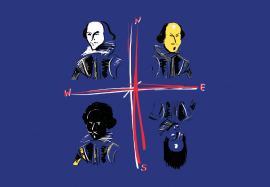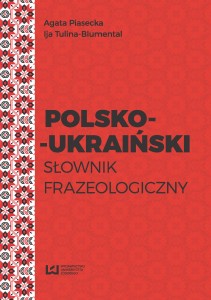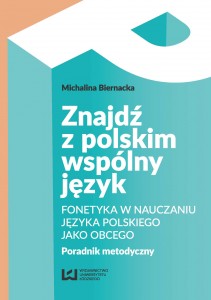Multicultural Shakespeare: Translation, Appropriation and Performance Vol. 25 No. 40: Shakespeare and Ideology on Page and Stage
Opublikowano: 21 grudnia 2022

Multicultural Shakespeare: Translation, Appropriation and Performance jest periodykiem o zasięgu międzynarodowym, poświęconym studiom szekspirowskim. Od 2003 wydawany jest przez Wydawnictwo Uniwersytetu Łódzkiego, red. Yoshiko Kawachi, Krystyna Kujawińska Courtney. Wcześniej, tj. od 1972 ukazywał się jako Shakespeare Translation; od 1986 jako Shakespeare Worldwide: Translation and Adaptation, red. Yoshiko Kawachi.
Od początku istnienia, Multicultural Shakespeare wzbudzał zainteresowanie badaczy z różnych zakątków świata, z czasem stał się istotną publikacją z zakresu studiów szekspirowskich o zasięgu międzynarodowym. Pierwotnie poświęcony głównie przekładom, przekształcił się w periodyk, zajmujący się adaptacjami/przywłaszczeniami tekstów Szekspira, nowymi odczytaniami i inspiracjami jego dziełami.
Multicultural Shakespeare: Translation, Appropriation and Performance stanowi forum, dzięki któremu naukowcy, zwłaszcza pochodzący z krajów nieanglojęzycznych, mogą analizować lokalne zagadnienia, przyczyniając się tym samym do zrozumienia Szekspira jako globalnego fenomenu. Periodyk stwarza możliwość spojrzenia na uniwersalny wymiar dzieł Szekspira, wydobywając ich lokalne wartości kulturowe np. australijskie, brazylijskie, chińskie, finlandzkie, francuskie, niemieckie, greckie, izraelskie, japońskie, koreański, polskie, rumuńskie, rosyjskie, hiszpańskie, czy też amerykańskie i brytyjskie. Istotnym elementem w publikacjach jest ontologiczne i międzykulturowe znaczenie dzieł Szekspira.
W numerze:
Thematic Volume Introduction: Shakespeare and Ideology on Page and Stage
Krystyna Kujawińska Courtney
Taming the Glitter Ball: A Diagnosis of Shakespeare ‘for all time’—Sketched from South Africa
Laurence Wright
Shakespeare travels the globe more variously and unpredictably than any other dramatist. In performance his texts have shown themselves hospitable to vastly different ideological interpretations. By making these two points, I do not mean that Shakespeare pops up around the globe, sometimes in quite extraordinary guises, without rhyme or reason. Far from it. Where Shakespeare makes his appearance this is an act of deliberate choice, by a producer, a production company, an arts foundation, a school or university, a national arts authority, or even simply an ad hoc group of Shakespeare enthusiasts. His advent is always intentional, and often contextually explicit, whatever the rationale. But the sheer variety of guises in which his work appears, the disparate cultural and ideological vogues that attach to his work, the geographical spread of art pieces, performances and installations based on Shakespeare, not to mention the diverse artistic disciplines which seize on him as an inspiration, calls for explanation. No other artist in any medium exhibits comparable artistic fertility across time and space. To claim the limelight for more than 400 years without any sign of diminution is remarkable. This article seeks to understand why this ubiquity is possible. Specifically, is there a definable textual mechanism underlying his historical and international success? At the outset it should be indicated that this paper focuses on a technical diagnosis of textual prerequisites for Shakespeare’s international success. It is not about what his plays say or mean, and only incidentally about the values they exemplify. While the paper sets out to describe textual features which make possible some of his manifold theatrical enchantments, there is no intention to describe, evoke, or celebrate those enchantments.
Naked Villany: The Fatal Attraction of Richard III and Donald Trump
David Livingstone
Although no longer American President, Donald Trump still manages to upstage the current administration. An explanation for his “sinister aesthetics”, to use Joel Elliot Slotkin’s concept, can be seemingly found in developing a comparison with the eponymous king of Shakespeare’s Richard III, who masterfully employs soliloquies and asides to draw the audience and reader into his evil plots and dealings. Donald Trump also managed something similar by means of Twitter, constantly tweeting out vicious comments and insults, which kept both his followers and opponents engaged. This theatrical skill is also compared to the ‘heat’ generated by villains in professional wrestling, whose popularity is marked by how much hatred they can produce.
Stan Reiner van Zon
“Hamlet”, “Macbeth”, Anantanarayanan’s “The Silver Pilgrimage” and A Touch of Occidentalism
Mythili Kaul
The article focuses on an encounter with Shakespeare in an unusual place, a novel set in medieval India, where Shakespeare is viewed and assessed by an Indian audience, by Indian listeners, through principles of classical Indian art and thought. Such an encounter creates a sense of incongruity, an incongruity that is cultural, philosophical and aesthetic, but at the same time leads to startling perspectives and new and fresh insights. The novel does not privilege one culture over another but the listeners do and we have a brilliant piece of comic writing where the humour derives from the one-sidedness of their perceptions, their “occidentalism”, their easy assumption of the superiority of their belief system over the “other”. The Silver Pilgrimage thus provides not only a stimulating perspective on two Shakespearean tragedies from the point of view of Sanskrit poetics and Indian thought, but also a gentle expose of the limitations of this point of view, and the cultural chauvinism that lies behind it.
Boram Choi
This article explores the psychology that motivates Yang Jung-Ung and his actors in the process of translating Shakespeare’s A Midsummer Night’s Dream into a Korean style. By focusing on the ways of showing the theme of the play in modern styles fused with traditional modes of theatrical practice, the director attempts to develop his own ways of expression to communicate with the modern Korean audience. In this process, Yang reconstructs the dialogues between the characters rather than rely heavily on Shakespeare’s text and language. For this reason, his production has often been criticised for missing Shakespeare’s poetry. However, the beauty of poetry is not only in Shakespeare’s language itself, but rather it is in the mental process of how the artist and audiences understand and translate its meaning in their cultural contexts. Shakespeare’s language includes a great deal of imagery that provides the artists with concrete information for constructing the stage mise-en-scène. In Yang’s production, Shakespeare’s poetry is expressed through the visual images created by the performer’s physical bodies, which reflects the director’s interpretation of the play in his cultural context. By analysing the performers’ physical movements, this article studies how Yang perceives the theme of Shakespeare’s Dream in relation to a Korean cultural context and presents his unique vision on the play.
The Enemy Other: Discourse of Evil in William Shakespeare’s “The Tempest”
Ayman Abu-Shomar
Caliban, the ‘enemy Other’ of William Shakespeare’s The Tempest, is a character that allows further investigations of the colonial ideology in its earliest forms; locating ‘evil’ forces outside the continent of Europe and the White race. Caliban, the only non-European character, is typified as the autocratic antagonist of the play whose evil intentions and actions cannot be redeemed. Against such representation, the essay argues that the villainous discourse attributed to Caliban is informed by Renaissance theological doctrines escorted by an emergent colonial ideology. It argues that, at a semantic level, the employment of the concept of ‘evil’ often serves as an intensifier to denounce wrongful actions. At a moral level, however the term is often contested on the basis that it involves unwarranted metaphysical commitments to dark spirits necessitating the presence of harmful supernatural creatures. To attribute the concept to human beings is therefore essentially problematic and dismissive since it lacks the explanatory power of why certain people commit villainous actions rather than others. Hence, the epistemological aporia of Caliban’s ‘evil’ myth reveals an inevitable paradox, which concurrently requires locating Caliban both as a human and unhuman figure. Drawing on a deconstructionist approach, the essay puts the concept of ‘evil’ under erasure, hence, argues that Caliban’s evilness is a mere production of rhetoric and discourse rather than a reality in itself. This review contributes to the intersecting areas of discourse, representations, and rhetoric of evil within the spectrum of postcolonial studies.
Writing and Rewriting Nationhood: “Henry V” and Political Appropriation of Shakespeare
Hikaru Minami
Mitashree Tripathy
Shakespeare’s comedies mark his artistic excellence in the portrayal of woman characters. Shakespearean women have invariably moved the audience and their understanding towards them from being sweet and mawkish to expressing their needs sternly for integrity, justice through wit and intelligence in his plays. Often strongly approved by the modern feminists, the qualities of intelligence and assertiveness are regarded as admirable qualities in Shakespearean comic heroines. As revolutionaries, Shakespearean female characters have always been projected as strong, sometimes stronger than the male counterparts; often going against the conventions of the society to symbolize what gender equality in the future may be like. Essential qualities like intelligence and wit always fulfilled and made Shakespearean heroines independent personalities. The female characters in Shakespeare’s plays always played an important role in the dramatic run in both tragedies and comedies. This article studies the portrayal of intelligence by Portia in The Merchant of Venice making her the hero of the play.
Epitomes of Dacia: Wallachia, Moldavia, and Transylvania in Early Modern English Travelogues
Monica Matei-Chesnoiu
This essay examines the kaleidoscopic and abridged perspectives on three early modern principalities (Wallachia, Moldavia, and Transylvania), whose lands are now part of modern-day Romania. I examine travelogues and geography texts describing these Eastern European territories written by Marco Polo (1579), Abraham Ortelius (1601; 1608), Nicolas de Nicolay (1585), Johannes Boemus (1611), Pierre d’Avity (1615), Francisco Guicciardini (1595), George Abbot (1599), Uberto Foglietta (1600), William Biddulph (1609), Richard Hakluyt (1599-1600), Fynes Moryson (1617), and Sir Henry Blount (1636), published in England in the period 1579-1636. The essay also offers brief incursions into the representations of these geographic spaces in a number of Shakespearean plays, such as The Merchant of Venice and Othello, as well as in Pericles, Prince of Tyre by Shakespeare and Wilkins. I argue that these Eastern European locations configure an erratic spatiality that conflates ancient place names with early modern ones, as they reconstruct a space-time continuum that is neither real nor totally imaginary. These territories represent real-and-fictional locations, shaping an ever-changing world of spatial networks reconstructed out of fragments of cultural geographic and ethnographic data. The travel and geographic narratives are marked by a particular kind of literariness, suggesting dissension, confusion, and political uncertainty to the early modern English imagination.
Komentarze
Ten post dostępny jest także w języku: angielski





